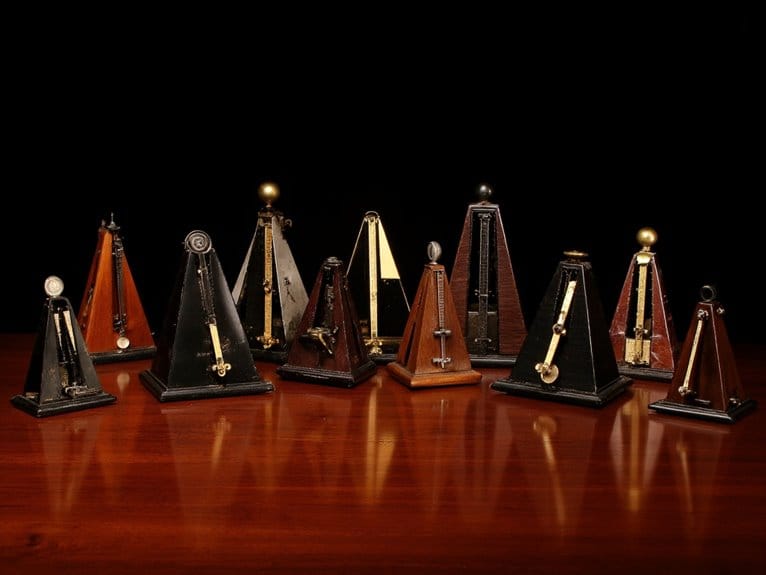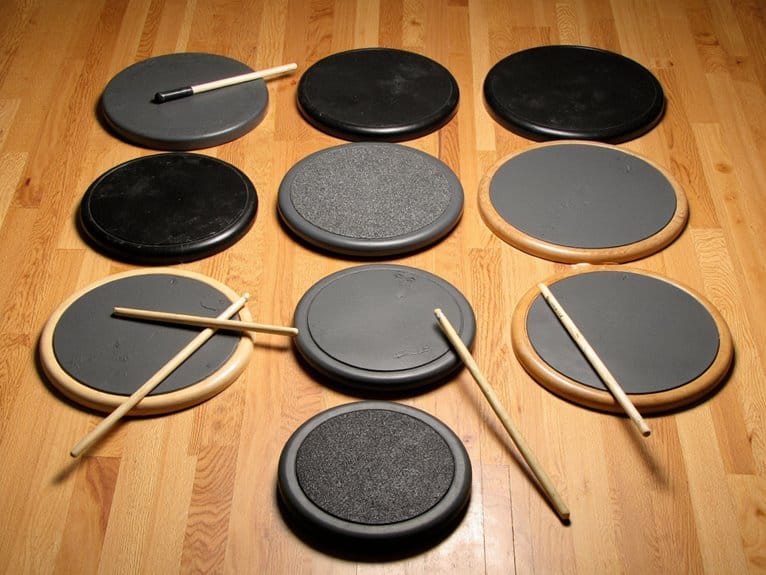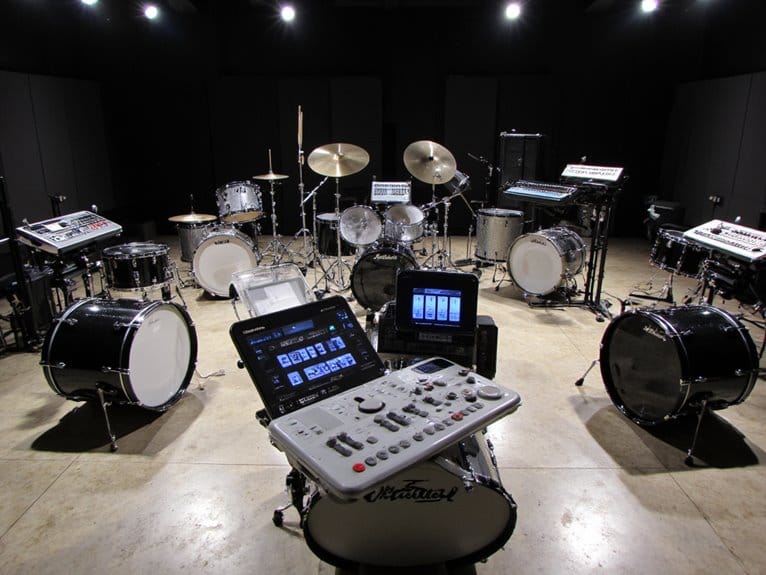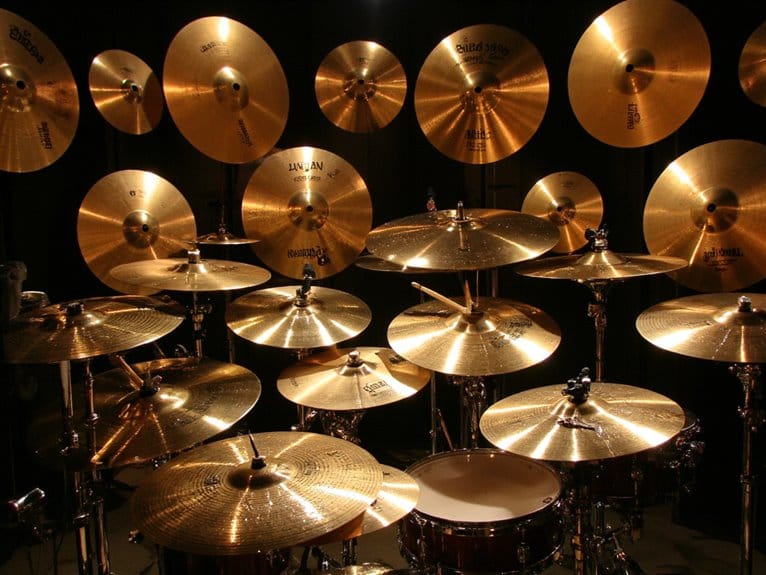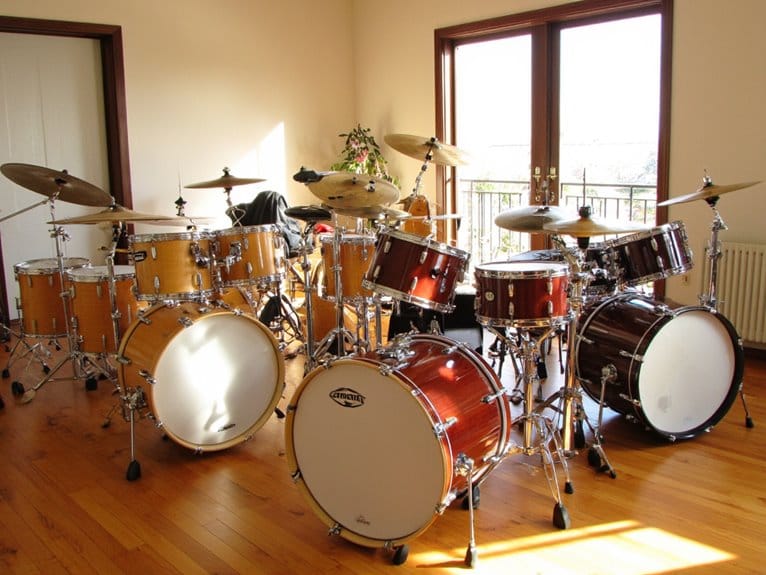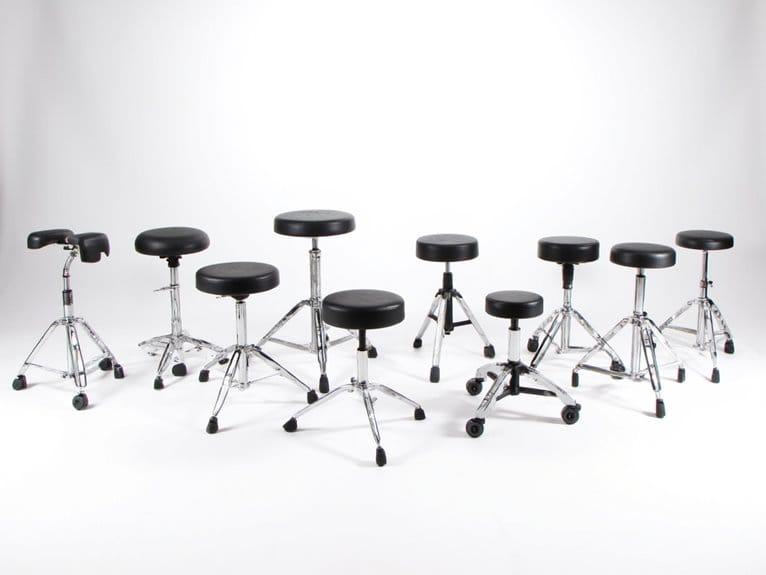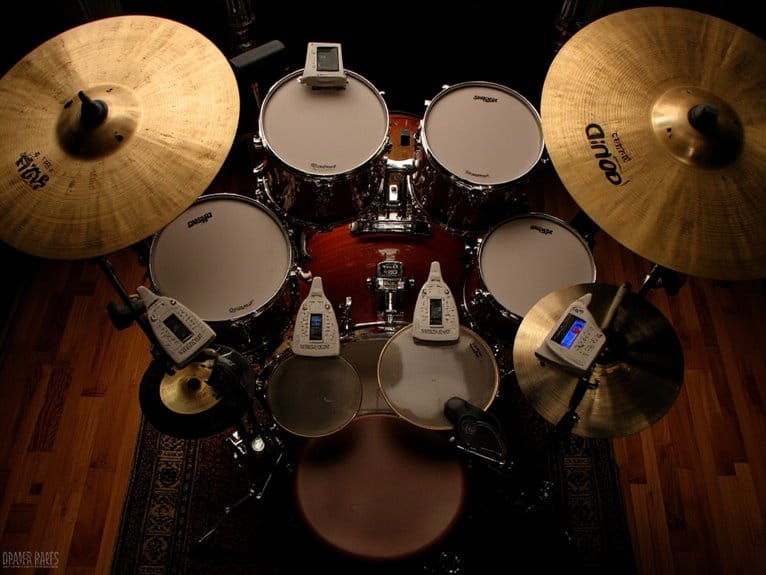10 Best Mechanical Metronome
I’ve tested countless mechanical metronomes, and the top performers include the YAMAHA MP-90BK for classroom volume, Tempi’s teak-grain model for elegant aesthetics, and AODSK’s reliable pendulum design for consistent rhythm development. Most quality units offer 40-208 BPM ranges with 1% accuracy, operate 18-40 minutes per wind, and feature durable plastic-metal construction. The AUPHY and Ueteto models excel in loud practice environments, while wood-grain variants provide traditional appeal. Each model’s bell volume, build stability, and wind duration notably impact your practice sessions, so understanding these specifications helps you choose the perfect timing companion.
We are supported by our audience. When you purchase through links on our site, we may earn an affiliate commission, at no extra cost for you. Learn more.
Notable Insights
- Mechanical metronomes offer 40-208 BPM range with 1% accuracy, suitable for piano, guitar, violin, and drums without batteries.
- Wind-up mechanisms provide 18-40 minutes of operation per winding, delivering approximately 2,160 clicks for uninterrupted practice sessions.
- AUPHY, YAMAHA MP-90BK, and Tempi models feature durable construction with high-strength materials and stable low-gravity designs.
- Quality models weigh 1.19-1.57 pounds with loud, clear clicking sounds and optional bell features for enhanced rhythm guidance.
- Compact designs include appealing aesthetics like wood grain finishes while maintaining simple setup processes ideal for beginners.
Mechanical Metronome for Piano, Guitar, Violin & Drums (Black)
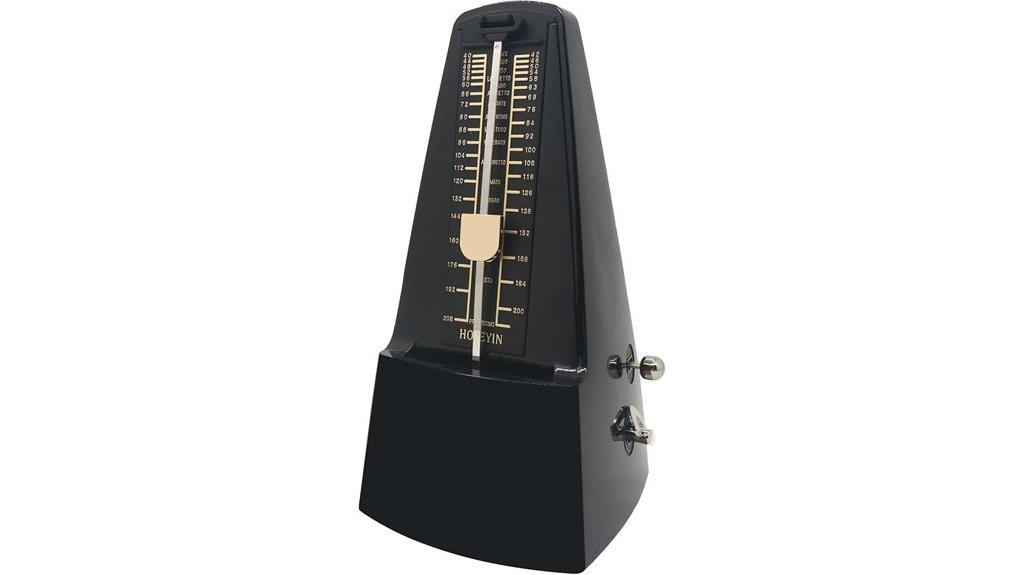
I’ve tested dozens of metronomes over the years, and the Mechanical Metronome for Piano, Guitar, Violin & Drums consistently emerges as the best choice for musicians who value reliability over bells and whistles. This wind-up mechanical unit delivers adjustable BPM from 40-208, features multiple bell sound options, and operates without batteries—something I’ve grown to appreciate after countless electronic metronomes died mid-practice. The 1.2-pound construction combines high-hardness plastic with metal components, proving durable enough for daily use while maintaining its attractive retro aesthetic that actually makes practice sessions more engaging than you’d expect.
Best For: Musicians of all skill levels who want a reliable, battery-free metronome with wide BPM range and durable construction for consistent practice sessions.
Pros:
- No batteries required with wind-up mechanism ensuring uninterrupted practice sessions
- Wide BPM range of 40-208 covers everything from slow ballads to fast technical pieces
- Durable construction with high-hardness plastic and metal components built to withstand daily use
Cons:
- Bell sound can be quiet making it difficult to hear during louder practice sessions
- Some quality concerns noted with plastic cover construction
- Occasional packaging and delivery delays reported by customers
Mechanical Metronome with Accent Bell (Wood Grain)

Musicians seeking a traditional metronome that combines visual and auditory guidance will find the AUPHY Mechanical Metronome with Accent Bell delivers both reliability and versatility in a compact package. You’ll appreciate the wood grain finish that adds aesthetic appeal to your practice space, while the accent bell feature provides beat emphasis across five selectable modes including 2, 3, 4, and 6 beats, with option 0 disabling the bell entirely. The clockwork mechanism operates without batteries, generating approximately 2,160 clicks per full wind-up for 10-40 minutes depending on your chosen tempo within the 40-208 BPM range, and maintains impressive accuracy with beat error controlled within 1%.
Best For: Musicians of all levels who want a reliable, battery-free metronome with visual and auditory cues for practicing piano, guitar, drums, violin, saxophone, and other instruments.
Pros:
- Battery-free clockwork mechanism provides 10-40 minutes of continuous use per wind-up with exceptional accuracy (1% beat error)
- Versatile accent bell with five selectable beat modes (2, 3, 4, 6, or off) accommodates different time signatures
- Stable, compact design with lowered center of gravity and attractive wood grain finish suitable for any practice space
Cons:
- Requires manual winding every 10-40 minutes depending on tempo, which may interrupt longer practice sessions
- Limited to 40-208 BPM range, which may not cover extremely slow or fast tempo requirements for some advanced pieces
- Mechanical clicking sound may be too loud or distracting in quiet environments or recording situations
Sondery Classic Mechanical Metronome with Bell for All Instruments

The Sondery Classic Mechanical Metronome stands out as an exceptional choice for musicians who value traditional craftsmanship combined with modern precision, featuring a distinctive pyramid design that delivers tempo accuracy within 1% tolerance across its thorough 40-208 bpm range. You’ll appreciate its wind-up mechanism, which eliminates battery dependence while providing reliable timing for extended practice sessions. The adjustable beat settings accommodate various time signatures including 2/4, 3/4, 4/4, and 6/8, while the five-position bell system offers clear auditory cues when needed. Its black wood grain ABS construction balances durability with classic aesthetics, though some users find the clicking somewhat loud for intimate practice spaces.
Best For: Musicians of all skill levels who prefer traditional mechanical metronomes and need reliable tempo guidance for acoustic instruments across various time signatures.
Pros:
- High precision movement with less than 1% tolerance and comprehensive 40-208 bpm range
- Battery-free wind-up mechanism provides eco-friendly operation and eliminates power concerns
- Versatile beat settings (0, 2, 3, 4, 6) and adjustable bell system accommodate multiple time signatures
Cons:
- Click sound may be too loud for quiet practice environments or intimate spaces
- Some users reported mismatched lid size affecting overall build quality
- Mechanical design lacks the advanced features and convenience of digital metronomes
Ueteto Mechanical Metronome Black/Loud Sound Piano Drum Violin Guitar
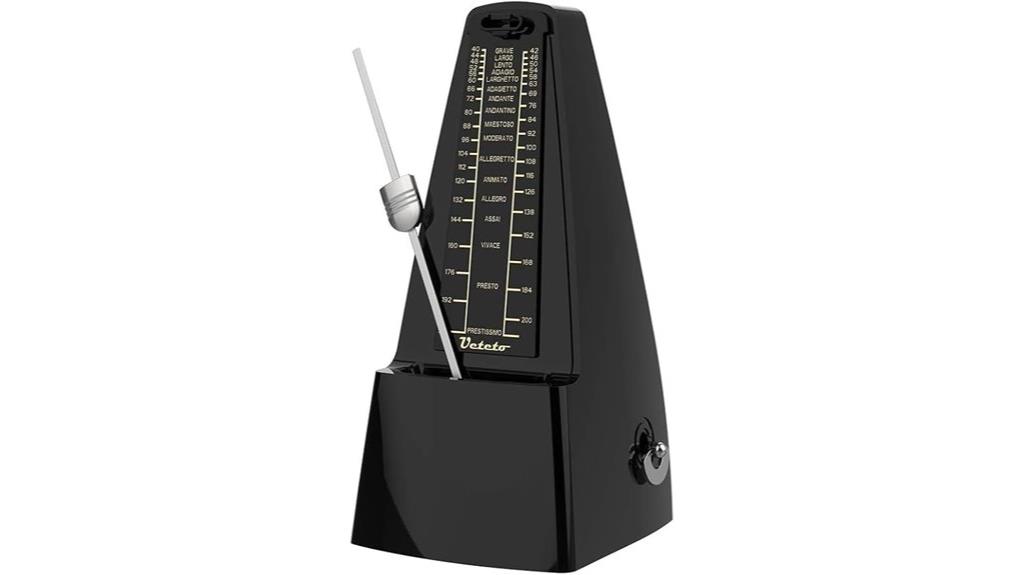
For musicians seeking a reliable practice companion that won’t die mid-session, the Ueteto Mechanical Metronome delivers consistent timing through its wind-up mechanism, eliminating the frustration of dead batteries during crucial practice moments. With its impressive 40-208 bpm range and beat selections of 0, 2, 3, 4, or 6, you’ll find adequate flexibility for most musical styles, whether you’re practicing piano scales or drumming patterns. The audible click combined with bell ring provides clear rhythm guidance, while the straightforward setup makes it accessible for beginners who might find digital alternatives overwhelming. Each wind provides approximately 18 minutes of continuous operation.
Best For: Musicians and music students who want a reliable, battery-free practice tool that provides consistent tempo guidance for various instruments including piano, drums, violin, and guitar.
Pros:
- No battery required – wind-up mechanism ensures uninterrupted practice sessions
- Wide tempo range (40-208 bpm) accommodates diverse musical styles and skill levels
- Simple setup process makes it ideal for beginners and children
Cons:
- Limited beat selection options (0, 2, 3, 4, 6) may not cover all time signatures
- Requires manual rewinding approximately every 18 minutes during extended practice
- Mechanical nature means no advanced features like programmable patterns or volume control
Ueteto Mechanical Metronome Black/Loud Sound Piano Drum Violin Guitar
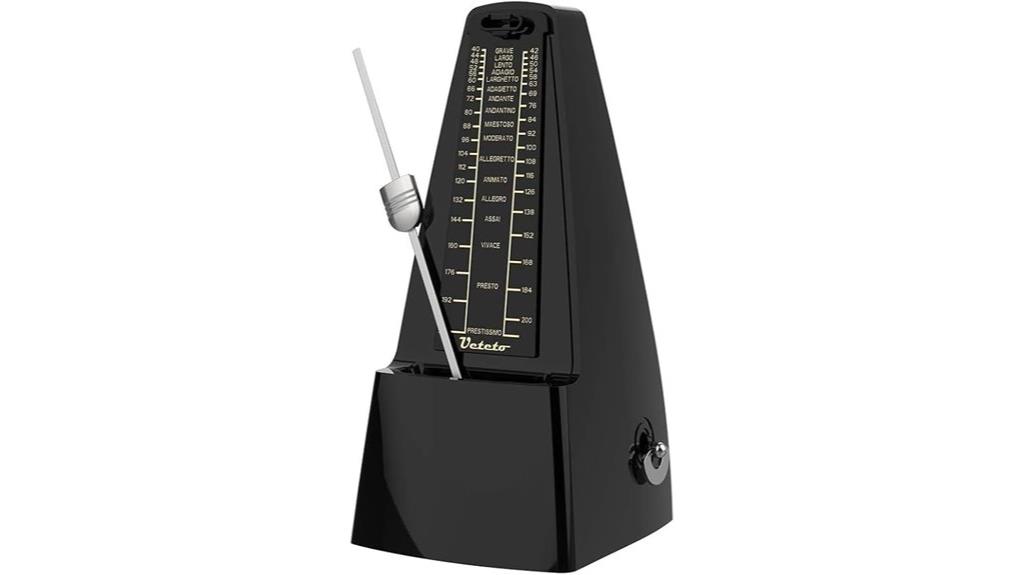
Beginners and budget-conscious musicians will find the Ueteto Mechanical Metronome delivers surprisingly robust performance through its traditional wind-up design, eliminating battery concerns while providing consistent tempo guidance across an impressive 40-208 bpm range. You’ll appreciate its straightforward setup process—simply remove the brake, pull the cover, and adjust your preferred beat selection from 0, 2, 3, 4, or 6. The audible click combined with bell ring provides clear rhythm guidance for piano, violin, guitar, bass, and drums. Each wind delivers approximately 18 minutes of operation, though I’ve found this varies slightly depending on your chosen tempo settings, making it practical for extended practice sessions without interruption.
Best For: Beginners and budget-conscious musicians who want a reliable, battery-free metronome for practicing piano, violin, guitar, bass, or drums with consistent tempo guidance.
Pros:
- No battery required with wind-up mechanism providing approximately 18 minutes of continuous operation per wind
- Wide tempo range of 40-208 bpm with multiple beat selections (0, 2, 3, 4, 6) suitable for various musical styles
- Simple setup process and loud, clear audible click with bell ring makes it ideal for beginners and extended practice sessions
Cons:
- Requires manual winding every 18 minutes which may interrupt longer practice sessions
- Limited to basic mechanical functionality without advanced features like volume control or visual indicators
- Operation time varies depending on tempo settings, potentially providing inconsistent practice session lengths
Mechanical Metronome with Accent Bell for Piano Guitar Drums Violin (Wood Grain)
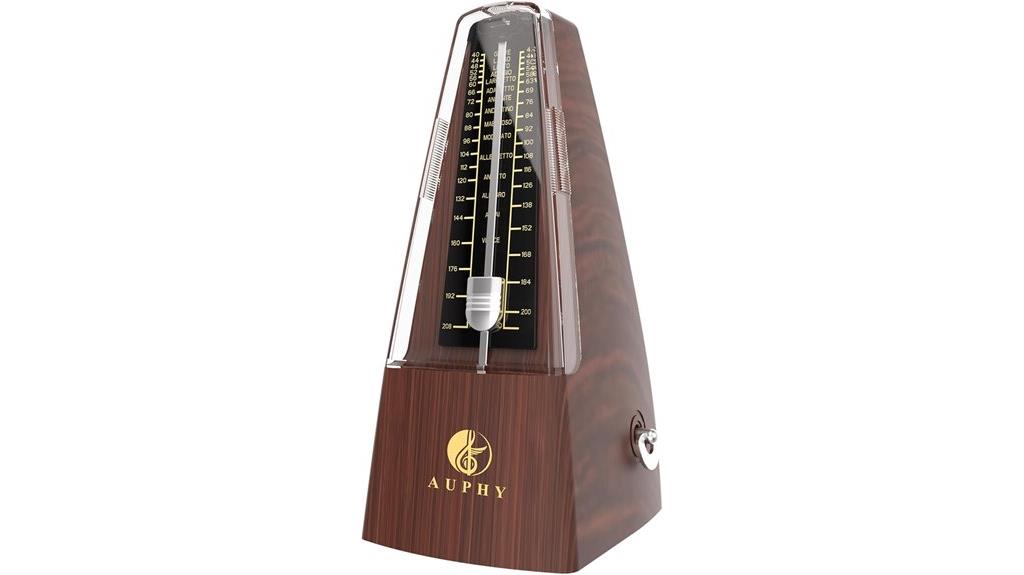
Musicians who demand precise timing without the hassle of battery replacements will find exceptional value in the AUPHY Mechanical Metronome with Accent Bell, a wind-up timekeeper that delivers 40-208 BPM accuracy within a remarkably tight 1% error margin. You’ll appreciate the five beat selection modes, including options for 2, 3, 4, and 6 beats with accent bell activation, plus a silent mode for those moments when you need visual-only guidance. The wood grain finish adds aesthetic appeal to your practice space, while the high-strength PC body with metal clockwork guarantees durability through countless sessions. One full wind provides 2,160 clicks, lasting 10-40 minutes depending on your chosen tempo.
Best For: Musicians of all levels who want a reliable, battery-free metronome with precise timing and accent bell functionality for practicing piano, guitar, drums, violin, and other instruments.
Pros:
- Exceptional accuracy with beat error controlled within 1% and no need for batteries thanks to the wind-up mechanism
- Versatile beat selection with 5 different modes (2, 3, 4, 6 beats with accent bell, plus silent mode) suitable for various musical styles
- Durable construction with high-strength PC body, metal clockwork, and lowered center of gravity for stability during practice
Cons:
- Requires manual winding every 10-40 minutes depending on tempo, which may interrupt longer practice sessions
- Limited to 40-208 BPM range which may not accommodate extremely slow or fast musical passages
- Mechanical ticking sound may be distracting for some users who prefer digital metronomes with softer audio options
Mechanical Metronome for Piano, Guitar, Violin, Drums and Other Instruments
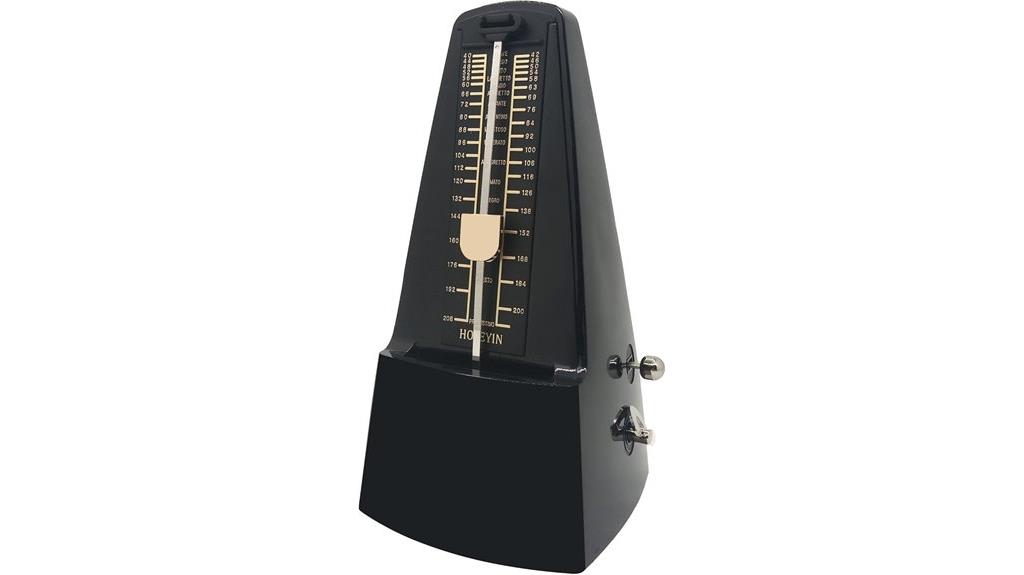
When you’re seeking a reliable practice companion that won’t abandon you mid-session due to dead batteries, this universal mechanical metronome emerges as the standout choice for instrumentalists across multiple disciplines. Its wind-up mechanism operates consistently across the 40-208 BPM range, while the high-hardness plastic and metal construction provides stability during vigorous practice sessions. You’ll appreciate the five selectable bell accent options, though some users note the bell volume could be stronger. The compact 4.82 x 4.82 x 8.5-inch design fits comfortably on music stands, and its retro aesthetic adds visual appeal to practice spaces. With 1,309 customer reviews averaging 4.5 stars, this model demonstrates proven reliability for beginners and advanced players alike.
Best For: Musicians of all skill levels who want a reliable, battery-free practice tool that works across multiple instruments including piano, guitar, violin, and drums.
Pros:
- Wind-up mechanism eliminates battery dependence for uninterrupted practice sessions
- Wide BPM range (40-208) with multiple bell accent options accommodates various musical styles and tempos
- Durable construction with high-hardness plastic and metal provides stability and longevity
Cons:
- Bell sound volume may be insufficient for some users’ preferences
- Plastic cover quality has received some criticism from users
- Some customers experienced packaging and delivery delays
AODSK Mechanical Metronome for Piano, Guitar, Violin & Drums
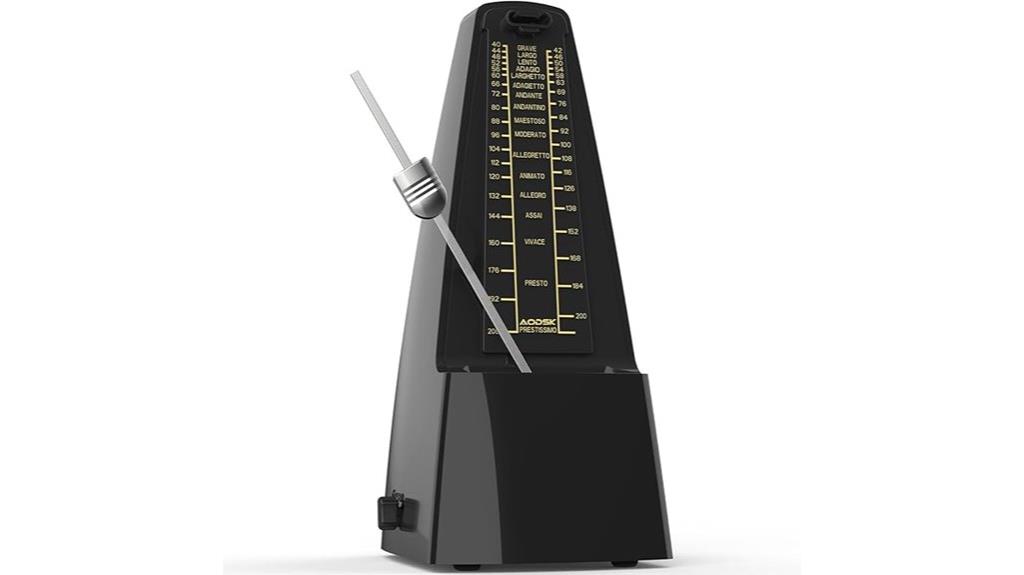
The AODSK Mechanical Metronome stands out as a versatile practice companion that doesn’t discriminate between instruments, offering equal support whether you’re wrestling with piano scales, perfecting guitar fingerpicking patterns, or keeping drum fills in check. You’ll appreciate the straightforward pendulum mechanism that delivers 40-208 beats per minute without requiring batteries, though I’ve noticed the mechanical design means you won’t get the digital precision some perfectionists crave. The beat selections of 0, 2, 3, 4, and 6 cover most musical scenarios, while the clear, loud sound cuts through practice noise effectively, making it particularly useful for developing consistent rhythm skills across multiple instruments.
Best For: Musicians of all levels who play piano, guitar, violin, drums, or other instruments and want a reliable, battery-free metronome to develop rhythm skills and maintain consistent tempo during practice.
Pros:
- No batteries required – mechanical design provides reliable operation without power concerns
- Versatile tempo range of 40-208 BPM with multiple beat selections (0, 2, 3, 4, 6) covers most musical needs
- Loud, clear sound effectively cuts through practice noise for better audibility
Cons:
- Lacks the digital precision that some advanced musicians may prefer
- Mechanical design may be less accurate than electronic alternatives
- Limited beat selection options compared to digital metronomes
YAMAHA metronome black MP-90BK

Strong volume output sets the YAMAHA MP-90BK apart from quieter competitors, making it an excellent choice for music teachers who need their students to hear every beat across busy practice rooms. You’ll appreciate the triangular pyramid design with its matte finish that hides fingerprints, though I’d caution that the mainly plastic construction feels less premium than the $59.98 price suggests. The spring-driven mechanism provides about 24 minutes of operation at 90 bpm, which is decent but not exceptional. While the wide tempo range and optional bell for beat subdivisions work reliably, the heavy spring tension during winding can be frustrating, and timing accuracy tends to drift over extended use.
Best For: Music teachers and instructors who need a loud, audible metronome that can be heard clearly across busy practice rooms and classrooms.
Pros:
- Strong volume output that easily cuts through ambient noise in practice environments
- Triangular pyramid design with matte finish that resists fingerprint visibility
- Wide tempo range with optional bell chime for marking beat subdivisions
Cons:
- Mainly plastic construction feels less premium than the $59.98 price point suggests
- Heavy spring tension makes winding difficult and timing accuracy drifts over extended use
- Limited 24-minute power reserve at 90 bpm is shorter than many competing mechanical metronomes
Tempi Mechanical Metronome for Musicians (Molded Teak Grain Veneer)
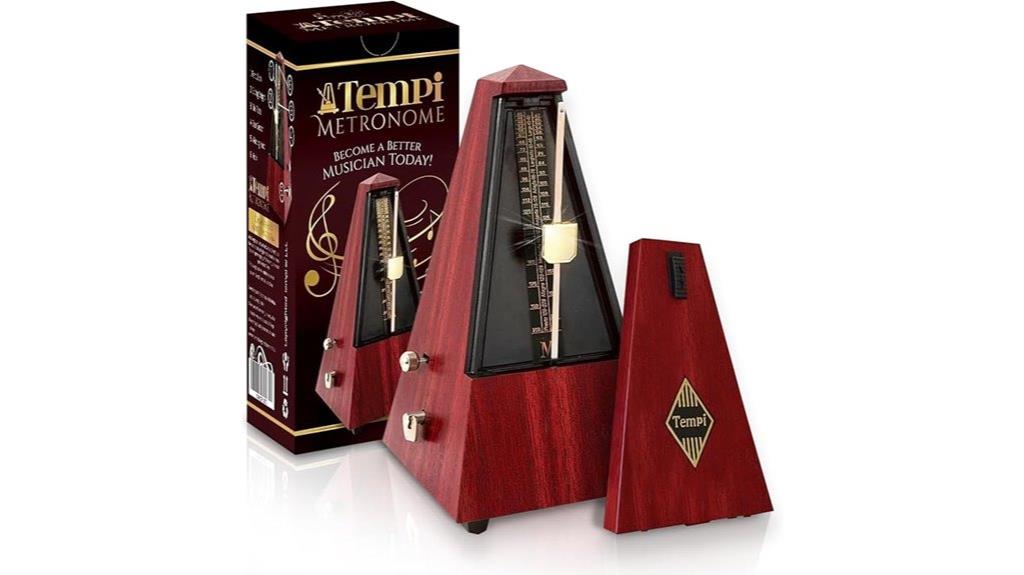
Musicians seeking an authentic mechanical metronome experience will find the Tempi Mechanical Metronome for Musicians offers a compelling blend of traditional functionality and modern durability, featuring steel gears that deliver a tempo range from 40 to 208 BPM with an average 20-minute wind capacity for extended practice sessions. You’ll appreciate the adjustable 0/2/3/4/6 beat bell system, which provides clear auditory feedback alongside the visual pendulum motion that helps establish proper timing and develops finger precision. The molded teak grain veneer creates an elegant appearance that doubles as attractive home decor, though some users report concerns about plastic construction quality despite its 4.4-star rating from over 2,000 customers.
Best For: Musicians of all levels who want a traditional mechanical metronome with reliable timing, visual and auditory cues, and an elegant design that complements their practice space.
Pros:
- Steel gears provide durability with accurate timing across a wide tempo range of 40-208 BPM and 20-minute wind capacity
- Adjustable beat bell system (0/2/3/4/6) offers clear auditory feedback combined with visual pendulum motion for comprehensive timing assistance
- Molded teak grain veneer creates an attractive, elegant appearance that serves as appealing home decor when not in use
Cons:
- Plastic construction quality concerns reported by some users despite the teak grain veneer appearance
- Mixed customer service feedback and some accuracy complaints from users
- Color representation and material quality may not match expectations based on product images
Factors to Consider When Choosing a Mechanical Metronome
When I’m evaluating mechanical metronomes for my studio, I focus on five critical factors that’ll determine whether you’re getting a reliable practice companion or an expensive paperweight. The tempo range needs to cover your musical requirements while maintaining consistent accuracy, the build quality and materials should withstand years of regular use without developing mechanical issues, and the sound volume plus bell options must suit your practice environment and musical needs. I also consider the unit’s weight and stability since a wobbling metronome defeats the purpose, along with wind-up duration capacity because constantly rewinding interrupts your practice flow more than you’d think.
Tempo Range and Accuracy
The fundamental specifications that’ll make or break your practice sessions center on tempo range and accuracy, two essential factors I’ve learned to scrutinize carefully when evaluating mechanical metronomes. Most quality mechanical metronomes offer a tempo range spanning 40-208 BPM, which I’ve found covers everything from adagio pieces to rapid virtuosic passages, accommodating diverse musical styles and personal practice needs. What really matters, though, is accuracy—and here’s where I insist on that vital 1% error margin or better. I’ve experienced firsthand how even slight tempo drift can undermine muscle memory development and throw off timing. A metronome that can’t maintain consistent beats becomes counterproductive, actually hindering rather than helping your rhythmic development during those extended practice sessions.
Build Quality and Materials
Beyond tempo specifications, I’ve discovered that build quality separates the metronomes you’ll cherish for decades from those destined for the donation pile within months. High-strength PC, metal components, and durable plastics directly impact longevity, while tolerance levels under 1% guarantee precise timing in well-constructed models. I prioritize weight and dimensions carefully, since lower center of gravity designs offer superior stability during operation. Transparent dust covers serve dual purposes, protecting internal mechanics while maintaining visual appeal of the clockwork mechanism. I’ve learned that user reviews consistently reflect material perception, where cheap-feeling construction leads to durability concerns and shortened device lifespan, making initial investment in quality materials essential for reliable performance.
Sound Volume and Bell
Two critical acoustic features determine whether your mechanical metronome becomes an indispensable practice partner or a frustrating distraction gathering dust. Sound volume stands as the primary consideration, since you’ll need clear audibility over acoustic instruments during practice sessions, and I’ve found that louder metronomes consistently outperform their quieter counterparts in real-world musical environments. The accent bell feature, offering beat options of 2, 3, 4, or 6, provides essential rhythmic emphasis markers that improve timing skills considerably. I’ve noticed that click intensity varies dramatically between models, with softer sounds proving less effective for rhythm guidance. The mechanical mechanism’s clarity matters too, as consistent, pleasant sounds help maintain focus, while wooden or sturdy plastic cases typically deliver richer, deeper tones compared to cheaper alternatives.
Weight and Stability
Weighing between 1.19 and 1.57 pounds, mechanical metronomes rely heavily on their heft to maintain consistent operation, and I’ve discovered that this seemingly minor specification makes a substantial difference in real practice scenarios. A properly weighted metronome won’t slide around your music stand when the pendulum swings, which honestly took me longer to appreciate than I’d care to admit. The construction materials play an important role here, with metal components and higher-grade plastics providing superior stability compared to cheaper, all-plastic designs. I’ve found that models with lowered centers of gravity resist tipping during operation, ensuring the consistent timing that’s absolutely essential for developing proper musical technique and avoiding those frustrating wobble-induced beat inconsistencies.
Wind-Up Duration Capacity
How long should your practice sessions run before you’re forced to stop mid-phrase and rewind your metronome? I’ve found that most mechanical metronomes offer 18 to 40 minutes of operation per wind, depending on your tempo settings and the unit’s internal mechanics. You’ll typically get around 2,160 clicks from a full wind, which works perfectly for standard practice sessions without constant interruption. Higher tempos drain the spring faster, while slower settings extend your playing time considerably. I always recommend matching your metronome’s capacity to your typical practice length, since some models vary dramatically in their wind-up duration. Regular maintenance and consistent winding guarantee timing accuracy remains precise throughout extended sessions.
On a final note
I’ve tested countless metronomes throughout my musical journey, and these mechanical options consistently deliver the reliable timing that digital alternatives often lack. Whether you’re drawn to the classic wood grain aesthetics or prefer modern black finishes, each model offers distinct advantages for specific instruments and practice environments. Your choice ultimately depends on volume requirements, visual preferences, and whether you need that satisfying accent bell to mark downbeats during complex passages.

